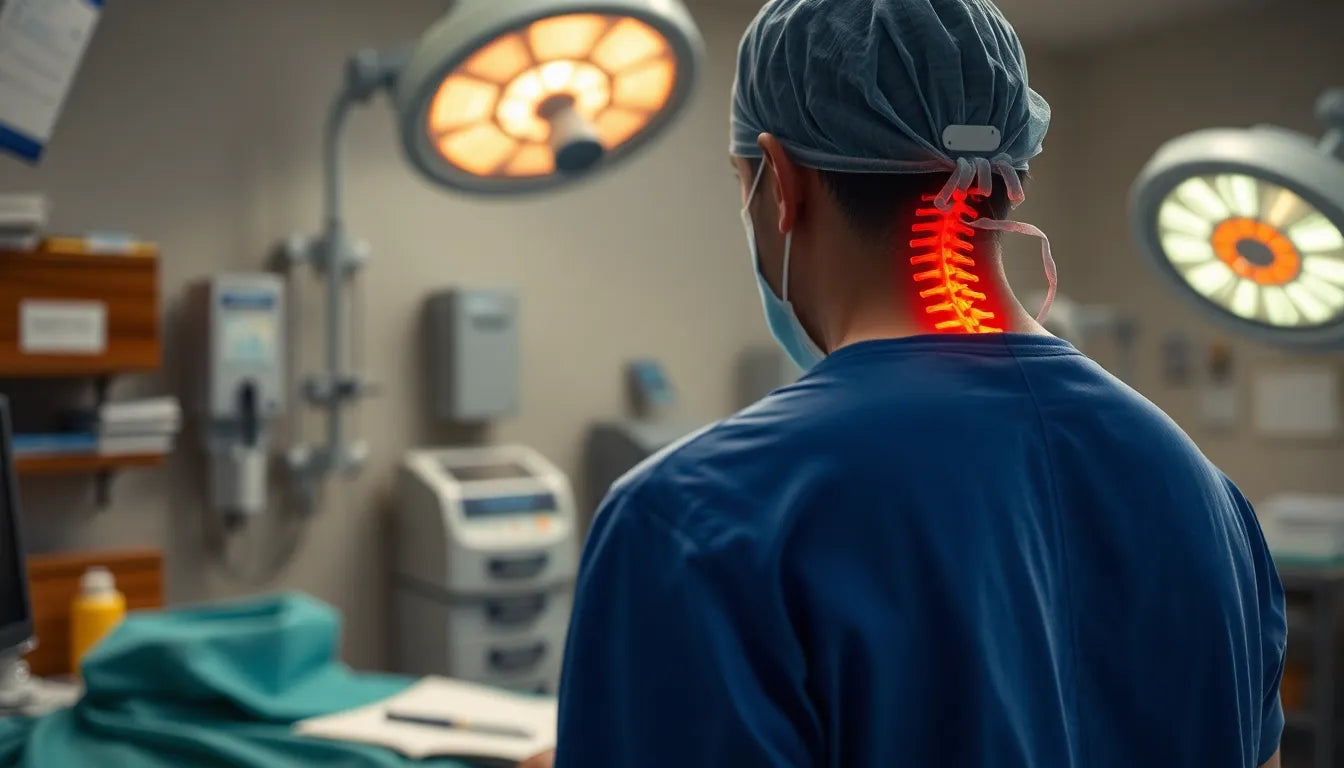Dealing with a herniated disc in the lower back can be a challenging experience, affecting not only your physical well-being but also your day-to-day activities. A herniated disc occurs when the soft, gel-like center of a spinal disc pushes through a crack in the tougher exterior casing. This condition is particularly common in the lumbar region, which is the lower part of the spine. The resulting pressure on nearby nerves can lead to a range of symptoms, including sharp pain, numbness, tingling, and muscle weakness.
Understanding a herniated disc
The lumbar spine is especially susceptible to herniated discs due to its role in supporting the upper body's weight and its involvement in various movements. When a disc herniates, it can impinge on the spinal nerves, causing discomfort and potential mobility issues. Common symptoms often start as a sudden, sharp pain in the lower back, which may radiate down the legs if the sciatic nerve is affected. This can be accompanied by numbness or a tingling sensation in the affected areas, and in severe cases, muscle weakness.
Herniated discs are more prevalent than many realize, and they can significantly impact one's quality of life. The discomfort and limitations imposed by this condition make finding effective solutions essential for those affected. Understanding the nature of a herniated disc is the first step toward managing its symptoms and seeking appropriate treatment.
The importance of early intervention
Addressing a herniated disc promptly is crucial to prevent further complications. Early intervention can not only alleviate immediate pain but also reduce the risk of chronic issues and the potential need for more invasive treatments later on. If left untreated, a herniated disc can lead to a progression of symptoms, including increased pain and further nerve damage, which can complicate recovery.
By seeking medical advice and exploring treatment options at the onset of symptoms, individuals can better manage their condition and maintain their quality of life. Early treatment often involves a combination of rest, physical therapy, and pain management strategies, which can help mitigate symptoms and promote healing.
Overview of treatment options
There is a wide range of treatment options available for managing a herniated disc, from conservative approaches to surgical interventions. The choice of treatment typically depends on the severity of the symptoms and the individual's overall health. Conservative treatments often include rest, activity modification, and physical therapy, aiming to relieve pain and improve function without surgery. In some cases, if these methods are not effective, surgical options may be considered to alleviate the pressure on the nerves.
In the following sections, we'll delve deeper into these treatment options, exploring both non-surgical and surgical approaches. We'll also highlight how ergonomic solutions can play a vital role in supporting recovery and preventing further injury, offering a comprehensive strategy for managing a herniated disc in the lower back.
Conservative treatments for herniated discs
When it comes to managing a herniated disc in the lower back, conservative treatments are often the first line of defense. These non-surgical approaches focus on alleviating pain and improving mobility without the need for invasive procedures.
Rest and activity modification
While rest is important, it should be limited to one or two days to prevent the negative effects of prolonged inactivity. Instead, modifying daily activities to avoid movements that strain the back is crucial. This might involve avoiding heavy lifting, twisting motions, and prolonged sitting or standing. Gradually resuming activity, guided by a healthcare professional, helps maintain flexibility and strength.
Pain management strategies
Pain management is a key component of conservative treatment. Nonsteroidal anti-inflammatory drugs (NSAIDs) such as ibuprofen and naproxen are commonly used to reduce inflammation and alleviate pain. Additionally, heat and cold therapy can be effective: applying cold packs helps reduce inflammation, while heat therapy promotes blood flow and healing.
The role of physical therapy and exercises
Physical therapy plays a pivotal role in the recovery from a herniated disc. A physical therapist can design a personalized exercise program to strengthen the muscles supporting the spine, improve flexibility, and reduce pressure on the affected disc. Exercises such as gentle stretching, core strengthening, and low-impact aerobic activities can be highly beneficial.
Exploring alternative therapies
Alternative therapies can complement traditional treatments and offer additional relief. Chiropractic care and spinal manipulation can help realign the spine and reduce nerve pressure, though it's important to consult with a healthcare provider to ensure these methods are appropriate. Massage therapy can also alleviate muscle tension, while acupuncture may provide pain relief by stimulating specific points on the body. Cognitive behavioral therapy (CBT) can help manage the psychological aspects of chronic pain, improving overall well-being.
Surgical interventions for herniated discs
In cases where conservative treatments fail to provide relief, or if symptoms are severe, surgical intervention may be necessary. Surgery is typically considered when there is significant nerve compression leading to persistent pain, weakness, or loss of function.
When is surgery necessary?
Surgery is often recommended when conservative methods do not yield results after several weeks or months, or if there is a risk of permanent nerve damage. Severe symptoms, such as loss of bladder or bowel control, also warrant immediate surgical evaluation.
Common surgical procedures
The most common surgical procedure for herniated discs is a microdiscectomy, where the herniated portion of the disc is removed to relieve nerve pressure. This minimally invasive procedure has a high success rate and typically allows for a quick recovery. Another option is a laminotomy and discectomy, which involves creating an opening in the lamina to access and remove disc material. In more severe cases, a lumbar laminectomy may be performed, where part or all of the lamina is removed to relieve pressure on the spinal cord or nerves.
Bridging to ergonomic solutions
While medical treatments address the immediate symptoms of a herniated disc, ergonomic solutions are essential for long-term management and prevention. Ergonomic adjustments in daily activities and work environments can significantly reduce strain on the lower back, supporting recovery and preventing recurrence. In the next section, we'll explore how ergonomic aids and strategies can complement medical treatments to provide comprehensive relief from a herniated disc.
Ergonomic solutions for managing a herniated disc
Incorporating ergonomic solutions into daily life is crucial for managing a herniated disc in the lower back. These adjustments can alleviate pain, support recovery, and prevent future issues.
Daily activity modifications
Maintaining proper posture during daily activities is essential for reducing strain on the lower back. Simple changes, such as keeping your back straight and knees slightly bent when lifting objects, can make a significant difference. Additionally, using ergonomic furniture, like chairs with lumbar support, can help maintain the natural curve of the spine and reduce discomfort.
Product-specific solutions
Several ergonomic products are designed to alleviate pain associated with a herniated disc. For instance, lumbar support cushions can provide additional support while sitting, and standing desks can encourage better posture throughout the day. Adjustable beds and supportive mattresses can also contribute to spinal alignment and comfort during sleep.
Workplace accommodations
Managing back pain at work requires a strategic approach. An ergonomic desk setup, including a chair with proper lumbar support and a monitor positioned at eye level, can reduce strain. Taking regular breaks to stand, stretch, and move around can also help maintain flexibility and prevent stiffness.
Prevention of recurrence
Preventing future herniated discs involves adopting a lifestyle that supports spinal health. Regular physical activity, including exercises that strengthen the core and improve flexibility, is vital. Maintaining a healthy weight reduces the pressure on the spine, while proper lifting techniques can prevent unnecessary strain. Additionally, incorporating ergonomic principles into daily routines can help sustain spinal health and reduce the risk of recurrence.
Frequently asked questions
What is the best sleeping position for a herniated disc?
Sleeping on your back with a pillow under your knees or on your side with a pillow between your knees can help minimize pressure on the spine. These positions promote natural spinal alignment and can alleviate discomfort.
Can a herniated disc heal on its own?
Yes, a herniated disc can heal on its own over time. The body can reabsorb the herniated material, and symptoms often improve with conservative treatment. However, the recovery process can vary based on factors such as the severity of the herniation and individual health conditions.
How long does it take to recover from a herniated disc?
Recovery time for a herniated disc varies. With conservative treatment, many individuals experience improvement within a few weeks to a few months. Surgical recovery may take longer, with most patients resuming normal activities within six weeks to three months, depending on the procedure.
Are there any activities I should avoid with a herniated disc?
It's advisable to avoid activities that exacerbate symptoms, such as heavy lifting, twisting motions, and high-impact sports. Instead, focus on low-impact exercises and movements that do not strain the back. Consulting with a healthcare provider can provide personalized guidance on safe activities.
Sources
- Mayo Clinic Staff. (2023). "Herniated disk." Mayo Clinic.
- Cleveland Clinic. (2023). "Herniated Disc." Cleveland Clinic.
- Spine-health. (2023). "Herniated Disc Treatment." Spine-health.
- American Academy of Orthopaedic Surgeons. (2023). "Herniated Disk in the Lower Back." OrthoInfo.
- University of Maryland Medical System. (2023). "Herniated Disk." University of Maryland Medical System.


















